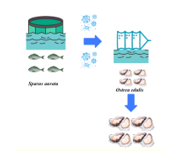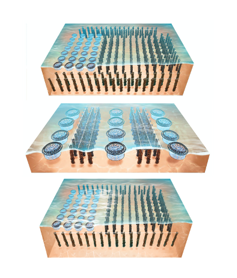INTEGRATING Ostrea edulis TO IMTA SYSTEMS IN ITALY: INSIGHTS FROM GROWTH, PROXIMATE COMPOSITION, AMINO AND FATTY ACID PROFILES
Keywords: Integrated Multi-trophic Aquaculture,
Ostrea edulis, growth, biodiversity, ecosystem
The European flat oyster (Ostrea edulis ), a filter-feeding bivalve and a high-value seafood product, faces significant challenges in cultivation, including limited production and ecological pressures. To explore its potential in ocean restoration and Integrated Multi-Trophic Aquaculture (IMTA) systems, a 390-day experiment was conducted (February 2023–March 2024) in Gaeta, Italy, in the Tyrrhenian Sea. Oysters were deployed in lantern nets at two locations: 20 m from fish farm cages (IMTA site) and 600 m away (Mono site). Sampling occurred bi-monthly, assessing growth parameters, specific growth rates (SGR), nutritional composition , amino and fatty acid profiles.
Initial mean weights of oysters (28.31±2.00 g), shell length (7.04±0.70 cm) and shell area (23.84±1.36 cm2) increased to 49.41±2.18 g, 8.36±0.05 cm, 34.23±2.69 cm 2 in the IMTA site and 52.65±2.76 g, 8.32±0.90 cm, 34.94±1.42 cm2 in the Mono site, respectively. Significant seasonal fluctuations in dry meat weights were observed, with oysters at the Mono site showing notably higher values by the end of the experiment. The specific growth rate (SGR) for shell length was 0.10% and for dry weight was 0.22% in both sites.
Nutritional analyses revealed distinct trends, with the highest protein content measured at 7.81±0.21% and lipid levels reaching a maximum of 1.31±0.05%. The Mono site oysters exhibited higher levels of n-3 polyunsaturated fatty acids (PUFAs) and essential amino acids. Seasonal variations were evident, with dry meat and nutrient levels peaking before spawning in April, declining after spawning in November, and increasing again by March in preparation for the next reproductive cycle.
In conclusion, optimal oyster growth was linked to 600 m distances from fish farm, where phytoplankton availability, enhanced by fish farm-derived nutrients, reached optimal levels. Oysters closer to the fish farm struggled with undiluted organic waste, impacting growth efficiency. Based on our findings and existing literature, we developed three productive models considering local hydrodynamics and nutrient distribution for oyster-IMTA. These models offer valuable guidance for Allocated Zone for Aquaculture (AZA) and Marine Spatial Planning (MSP) policies.

